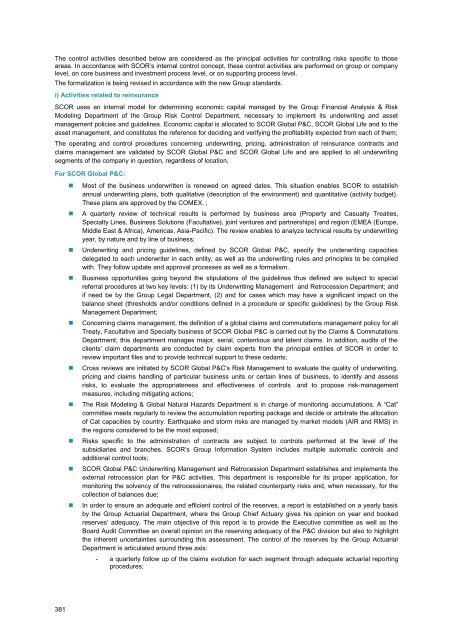4.4 Legal risk - Scor
4.4 Legal risk - Scor
4.4 Legal risk - Scor
You also want an ePaper? Increase the reach of your titles
YUMPU automatically turns print PDFs into web optimized ePapers that Google loves.
The control activities described below are considered as the principal activities for controlling <strong>risk</strong>s specific to those<br />
areas. In accordance with SCOR’s internal control concept, these control activities are performed on group or company<br />
level, on core business and investment process level, or on supporting process level.<br />
The formalization is being revised in accordance with the new Group standards.<br />
i) Activities related to reinsurance<br />
SCOR uses an internal model for determining economic capital managed by the Group Financial Analysis & Risk<br />
Modeling Department of the Group Risk Control Department, necessary to implement its underwriting and asset<br />
management policies and guidelines. Economic capital is allocated to SCOR Global P&C, SCOR Global Life and to the<br />
asset management, and constitutes the reference for deciding and verifying the profitability expected from each of them;<br />
The operating and control procedures concerning underwriting, pricing, administration of reinsurance contracts and<br />
claims management are validated by SCOR Global P&C and SCOR Global Life and are applied to all underwriting<br />
segments of the company in question, regardless of location.<br />
For SCOR Global P&C:<br />
• Most of the business underwritten is renewed on agreed dates. This situation enables SCOR to establish<br />
annual underwriting plans, both qualitative (description of the environment) and quantitative (activity budget).<br />
These plans are approved by the COMEX. ;<br />
• A quarterly review of technical results is performed by business area (Property and Casualty Treaties,<br />
Specialty Lines, Business Solutions (Facultative), joint ventures and partnerships) and region (EMEA (Europe,<br />
Middle East & Africa), Americas, Asia-Pacific). The review enables to analyze technical results by underwriting<br />
year, by nature and by line of business;<br />
• Underwriting and pricing guidelines, defined by SCOR Global P&C, specify the underwriting capacities<br />
delegated to each underwriter in each entity, as well as the underwriting rules and principles to be complied<br />
with. They follow update and approval processes as well as a formalism.<br />
• Business opportunities going beyond the stipulations of the guidelines thus defined are subject to special<br />
referral procedures at two key levels: (1) by its Underwriting Management and Retrocession Department; and<br />
if need be by the Group <strong>Legal</strong> Department, (2) and for cases which may have a significant impact on the<br />
balance sheet (thresholds and/or conditions defined in a procedure or specific guidelines) by the Group Risk<br />
Management Department;<br />
• Concerning claims management, the definition of a global claims and commutations management policy for all<br />
Treaty, Facultative and Specialty business of SCOR Global P&C is carried out by the Claims & Commutations<br />
Department; this department manages major, serial, contentious and latent claims. In addition, audits of the<br />
clients’ claim departments are conducted by claim experts from the principal entities of SCOR in order to<br />
review important files and to provide technical support to these cedants;<br />
• Cross reviews are initiated by SCOR Global P&C's Risk Management to evaluate the quality of underwriting,<br />
pricing and claims handling of particular business units or certain lines of business, to identify and assess<br />
<strong>risk</strong>s, to evaluate the appropriateness and effectiveness of controls and to propose <strong>risk</strong>-management<br />
measures, including mitigating actions;<br />
• The Risk Modeling & Global Natural Hazards Department is in charge of monitoring accumulations. A “Cat”<br />
committee meets regularly to review the accumulation reporting package and decide or arbitrate the allocation<br />
of Cat capacities by country. Earthquake and storm <strong>risk</strong>s are managed by market models (AIR and RMS) in<br />
the regions considered to be the most exposed;<br />
• Risks specific to the administration of contracts are subject to controls performed at the level of the<br />
subsidiaries and branches. SCOR’s Group Information System includes multiple automatic controls and<br />
additional control tools;<br />
• SCOR Global P&C Underwriting Management and Retrocession Department establishes and implements the<br />
external retrocession plan for P&C activities. This department is responsible for its proper application, for<br />
monitoring the solvency of the retrocessionaires, the related counterparty <strong>risk</strong>s and, when necessary, for the<br />
collection of balances due;<br />
• In order to ensure an adequate and efficient control of the reserves, a report is established on a yearly basis<br />
by the Group Actuarial Department, where the Group Chief Actuary gives his opinion on year end booked<br />
reserves‘ adequacy. The main objective of this report is to provide the Executive committee as well as the<br />
Board Audit Committee an overall opinion on the reserving adequacy of the P&C division but also to highlight<br />
the inherent uncertainties surrounding this assessment. The control of the reserves by the Group Actuarial<br />
Department is articulated around three axis:<br />
- a quarterly follow up of the claims evolution for each segment through adequate actuarial reporting<br />
procedures;<br />
381
















